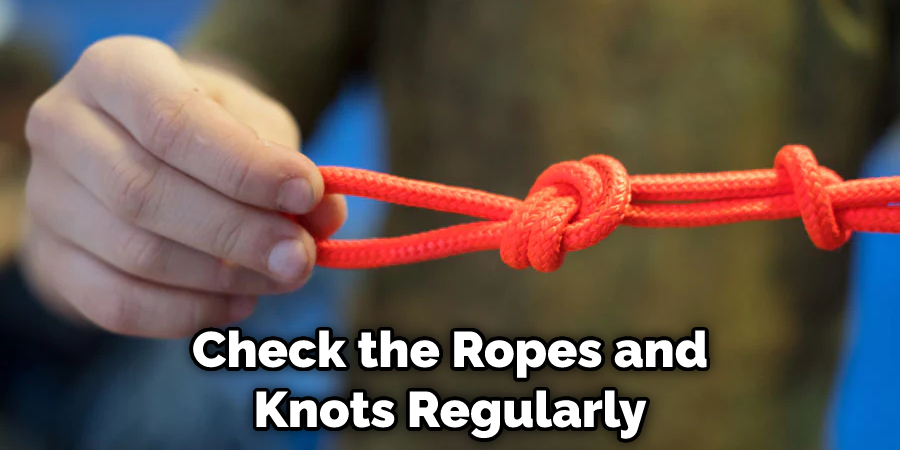Hanging a hammock chair is a great way to relax and unwind indoors or outdoors. Whether you’re looking to hang it in your bedroom, living room, or backyard, this guide will provide you with all the information you need to safely and securely hang your hammock chair. From the essential tools you’ll need to the step-by-step process, this guide will cover everything you need to know to ensure a successful and stress-free hanging experience. So grab your hammock chair, rope, and eye hooks, and let’s get started!

5 Step-by-Step Instruction for How to Hang a Hammock Chair
Here are five simple steps to follow to safely and securely hang a hammock chair:
Step 1: Essential Tools
In order to hang a hammock chair, you’ll need the following essential tools:
- Rope: This is the most essential component of hanging a hammock chair. You’ll need a strong and durable rope that can hold the weight of the chair and yourself. It’s recommended to use a rope that’s at least 1 inch in diameter and made of a material such as cotton, polyester, or nylon.
- Eye hooks or Swivel Hook with Spring, Chain, and Carabiner: Eye hooks are a standard method of hanging a hammock chair, as they provide a simple and easy way to attach the rope to the ceiling. A swivel hook with spring, chain, and carabiner can also be used but is more commonly used for outdoor hanging.
- Ceiling Joist or Structural Beam (for indoor hanging only): If you plan on hanging your hammock chair indoors, it’s important to hang it from a ceiling joist or structural beam, as a plaster or drywall ceiling alone will not provide enough support to hold the weight of an adult human. You may need a stud finder and screws to securely mount the eye hooks or swivel hook to the ceiling joist or structural beam.

Step 2: Preparation
Before hanging your hammock chair, it’s important to prepare and ensure that you have all the necessary tools and equipment at hand. Here’s what you need to do:
- Measure the height of your ceiling: Measure the height of your ceiling to determine how much rope you’ll need to hang the hammock chair.
- Determine the location of the ceiling joists or structural beams (if hanging indoors): If you’re hanging your hammock chair indoors, you’ll need to locate the ceiling joists or structural beams to hang the chair from. A stud finder can help you locate these.
- Gather the tools: Make sure you have all the tools you need before starting the installation process, including the rope, eye hooks or swivel hook, chain and carabiner, stud finder, and screws.
- Test the weight of the hammock chair: Before you begin hanging the chair, it’s important to test the weight of the chair to ensure it will hold. You can do this by gently pulling on the chair to see if it holds. You can also try sitting in the chair with your feet firmly on the ground to test its weight-bearing capacity.

Step 3: Hanging Process
Here is the process for hanging your hammock chair:
- Attach the rope to the eye hooks or swivel hook: If you’re using eye hooks, loop the rope through the eye screw and tie at least two half-hitch knots. If you’re using a swivel hook, attach it to the ceiling mount and screw it into the structural beam or ceiling joist.
- Weave the other end of the rope through the attachment of the hammock chair: Take the other end of the rope and weave it through the attachment of the hammock chair.
- Secure the rope with a strong knot or two: Make sure to secure the rope with a strong knot or two.
- Test the weight of the hammock chair: Pull gently on the hammock chair to make sure it’s secure and can hold weight. You can also try sitting in the chair with your feet on the ground to test its weight-bearing capacity.
- Adjust the height of the hammock chair: Once you’ve confirmed that the hammock chair is secure and can hold weight, you can adjust the height to your desired level.
- Use additional weights: You can place additional weights such as books or cans in the chair to further test its strength.
- Enjoy your hammock chair: Once you’re satisfied that the hammock chair is secure, you can enjoy it! Make sure to check the ropes and knots regularly to ensure that the chair remains secure.

Step 4: Safety Measures
Here are some important safety measures to keep in mind when hanging a hammock chair:
- Check the weight limit: Make sure the hammock chair you have can hold the weight of the person using it. The weight limit should be specified by the manufacturer.
- Use a secure ceiling or beam: The ceiling or beam that you hang the hammock chair from must be secure and able to hold the weight of the person using the chair. If you have a plaster ceiling, it’s not strong enough to support the weight of an adult, and if you have a drywall ceiling, it will crack and break upon anyone sitting in the hammock chair.
- Use proper knots: Make sure to use proper knots, such as half-hitch knots, to secure the rope to the eye hooks or swivel hook. Make sure the knots are tight and secure.
- Test the weight of the chair before use: Before using the hammock chair, make sure to test its weight-bearing capacity by pulling on it gently and sitting in it with your feet on the ground. If it holds, you can add more weight, such as books or cans, to further test its strength.
- Check the ropes and knots regularly: Make sure to check the ropes and knots regularly to ensure that the hammock chair remains secure and safe to use.
- Don’t swing too high: When using the hammock chair, make sure not to swing too high to avoid injury.
- Don’t use the hammock chair if it’s damaged: If the hammock chair or its ropes show any signs of damage or wear, don’t use it. It’s better to be safe than sorry.
By following these safety measures, you can ensure that your hammock chair is secure and safe to use.

Step 5: Additional Considerations
Additional considerations to keep in mind when hanging a hammock chair include the type of ceiling you have and its ability to support the weight of the chair and the user. It is essential to have a ceiling joist or a structural beam to hang the chair from. Plaster and lath alone are not enough to support the weight of an adult human, and drywall will almost immediately crack and break.
It is crucial to test the weight little by little, pull firmly on the hammock chair, and add more weight, such as books, to make sure it holds. It is also recommended to sit cautiously in the chair, with your feet firmly on the ground and your legs supporting most of your weight, until you are confident in the stability of the chair.
You Can Check It Out to Build a Hammock Chair Stand.
FAQs About Hanging a Hammock Chair
What is the Easiest Way to Hang a Hammock?
The easiest way to hang a hammock is to use tree straps or two lengths of rope for each end of the hammock and choose two sturdy trees about 14 to 16 feet apart that are large and healthy. Aim for a 30-degree hanging angle on both sides of the hammock and have it hang 12 to 18 inches off the ground. Avoid using trees with rotten parts or holes.
Is It Safe to Hang a Hammock Chair From the Ceiling?
Hanging a hammock chair from the ceiling is only safe if it is supported by a ceiling joist. Plaster and drywall are not strong enough to support the weight of an adult human, and will crack and break if the hammock is hung from them. The hammock chair should be anchored in beams and attached to eye hooks using a drill bit. For people weighing over 200 pounds, a single ceiling joist may not be enough to support the weight, so extra caution should be taken.
Conclusion
In conclusion, hanging a hammock chair can add a comfortable and relaxing seating option to your indoor or outdoor space. With the proper tools and preparation, the process of hanging a hammock chair is relatively straightforward. Essential tools include rope, eye hooks, half-hitch knots, and possibly a swivel hook with spring, chain, and carabiner. Preparation involves finding a suitable hanging location, measuring the height and distance between the eye hooks, and cutting the rope to the correct length.
The hanging process involves looping the rope through the eye hooks, tying tight knots, weaving the other end of the rope through the chair’s attachment, and testing the weight. It is crucial to follow safety measures such as ensuring the ceiling can support the weight of the chair and the user and testing the stability of the chair before use. With these tips and considerations, you can enjoy a comfortable and safe hanging hammock chair in no time.


